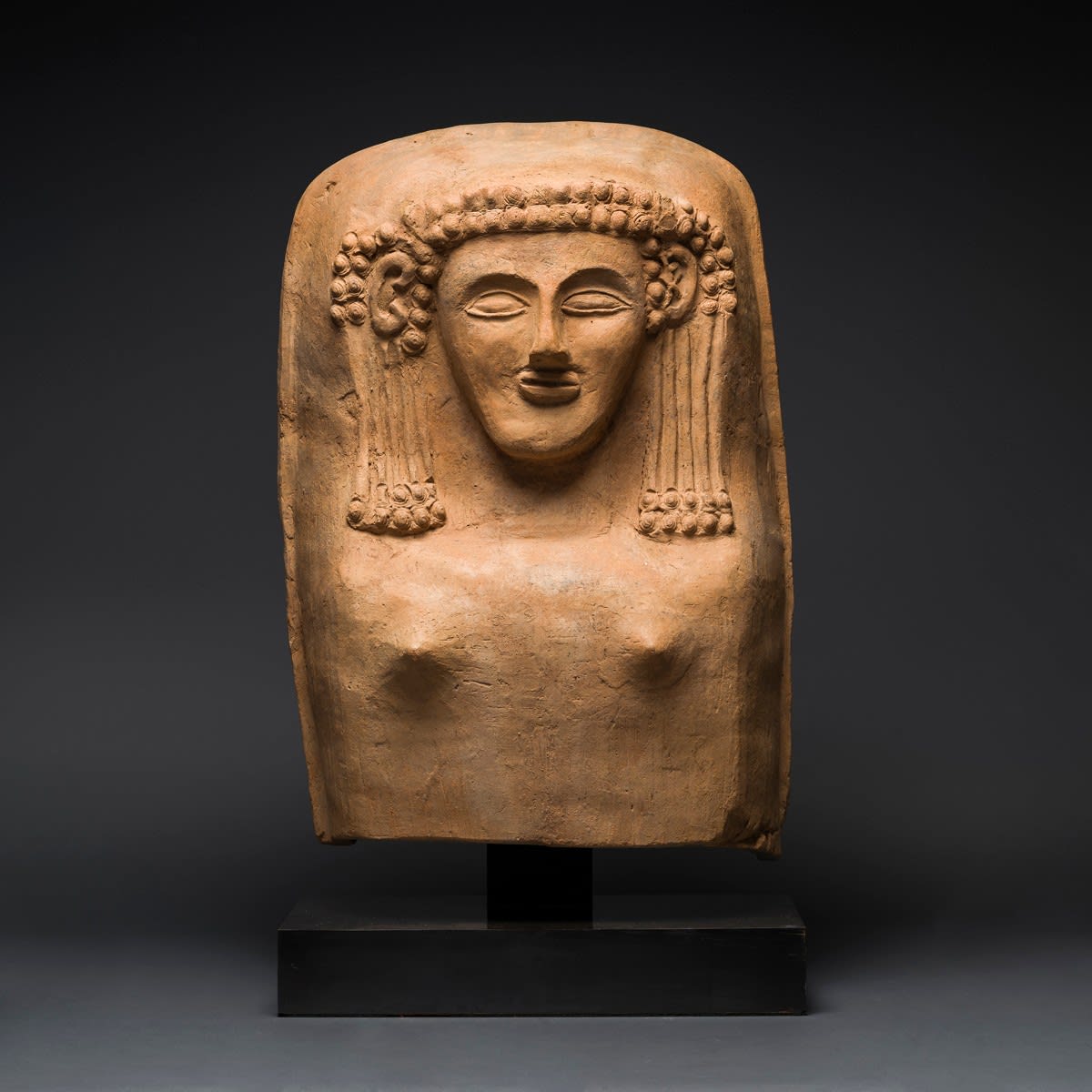Phoenician Anthropomorphic Coffin Lid, 600 BCE - 400 BCE
Terracotta
71.8 x 45.7 cm
28 1/4 x 18 in
28 1/4 x 18 in
LO.946
The Phoenician homeland was a coastal strip roughly corresponding to modern day Lebanon. ‘Phoenicia’ is a Greek word meaning red/purple and was used to refer to the people of the...
The Phoenician homeland was a coastal strip roughly corresponding to modern day Lebanon. ‘Phoenicia’ is a Greek word meaning red/purple and was used to refer to the people of the Levantine coast because the inhabitants of Tyre were renowned for their ability to produce fine purple dye. The dominant influence in the area lay with the city-states, especially Sidon, Byblos and Tyre. These cities were ruled separately but- despite their often hostile relations- their common maritime interests held the area together as a recognisable political entity. From the ninth century BC overseas colonies, at Carthage and Cyprus (Kition), reinforced the Phoenicians’ trade in the Mediterranean. Over the following centuries they established outposts further afield in Sicily and Spain. This expansion was motivated by the desire to find new markets for their goods and sources of precious metals which were particularly plentiful in the African interior and the Iberian coast.
The maritime success of the Phoenicians had two consequences for the arts. Firstly it provided the material wealth to support a large community of craftsmen. Secondly it brought the Phoenicians into contact with the visual arts of other cultures, especially the Egyptians and the Ionian Greeks. An Egyptian influence is particularly apparent in this magnificent terracotta coffin lid. The idea of creating a coffin in shape of a human being gradually evolved in Egypt as a result of the practice of mummification. From the late 3rd millennium BC masks were placed over the mummy’s face and gradually extended to cover the whole body. This example depicts the face and bust of a woman. The features are highly stylised with large almond shaped eyes, thick parted lips and a heart-shaped face. Several rows of round curls run along the top of the forehead and frame the large ears, which are depicted frontally. Long strands of hair, terminating the same style of round curls, frame the face and may represent a wig of some kind. The neck is only faintly indicated in the surface of the terracotta and there is no attempt to suggest the woman’s arms. The only feature on the bust itself is a pair of small cone-shaped breasts.
The contrast between the level of detail on the face and the relatively plain body is a feature of Phoenician funerary sculpture in other media. The famous marble tombs found at Sidon, which date from the 5th-4th centuries BC, feature extremely sophisticated carving on the face but the shape of the body is only hinted at or ignored completely.
The Phoenicians excelled in the production of terracotta figurines and masks which were exported all over the Mediterranean. As a material terracotta is both economical and malleable- yet it can be used to create extremely sophisticated works of art. This life-size coffin lid may well have been painted originally as there are traces of black pigment in the curls of the hair. There is a similar sarcophagus fragment in the Louvre, dated between the sixth and the fifth centuries BC. (AM)
The maritime success of the Phoenicians had two consequences for the arts. Firstly it provided the material wealth to support a large community of craftsmen. Secondly it brought the Phoenicians into contact with the visual arts of other cultures, especially the Egyptians and the Ionian Greeks. An Egyptian influence is particularly apparent in this magnificent terracotta coffin lid. The idea of creating a coffin in shape of a human being gradually evolved in Egypt as a result of the practice of mummification. From the late 3rd millennium BC masks were placed over the mummy’s face and gradually extended to cover the whole body. This example depicts the face and bust of a woman. The features are highly stylised with large almond shaped eyes, thick parted lips and a heart-shaped face. Several rows of round curls run along the top of the forehead and frame the large ears, which are depicted frontally. Long strands of hair, terminating the same style of round curls, frame the face and may represent a wig of some kind. The neck is only faintly indicated in the surface of the terracotta and there is no attempt to suggest the woman’s arms. The only feature on the bust itself is a pair of small cone-shaped breasts.
The contrast between the level of detail on the face and the relatively plain body is a feature of Phoenician funerary sculpture in other media. The famous marble tombs found at Sidon, which date from the 5th-4th centuries BC, feature extremely sophisticated carving on the face but the shape of the body is only hinted at or ignored completely.
The Phoenicians excelled in the production of terracotta figurines and masks which were exported all over the Mediterranean. As a material terracotta is both economical and malleable- yet it can be used to create extremely sophisticated works of art. This life-size coffin lid may well have been painted originally as there are traces of black pigment in the curls of the hair. There is a similar sarcophagus fragment in the Louvre, dated between the sixth and the fifth centuries BC. (AM)



